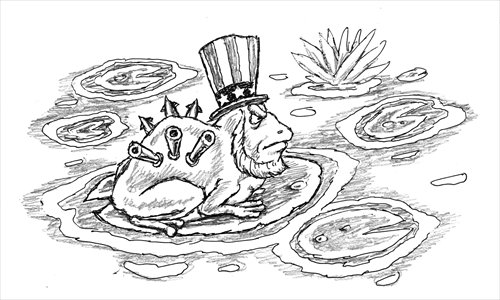HOME >> OP-ED
US facing challenges in strengthening Asian alliances as strategy shifts
By Son Key-young Source:Global Times Published: 2013-11-6 22:18:01

Illustration: Peter C. Espina/GT
Since October 1, the US has relocated 380 soldiers and 30 OH-58D Kiowa helicopters to Camp Humphreys, South Korea, from Joint Base Lewis-McChord in Washington state, an event regarded by some as a significant piece of the US strategic "rebalance" to the Asia-Pacific region.
In reality, however, it is a simple nine-month rotational tour, and the squadron was previously stationed in South Korea until its relocation to Iraq in 2008 and then to Washington.
Though the idea of the US "pivot" to Asia has been freshly articulated as the Obama administration's signature foreign policy initiative in 2011, what is actually taking place across the world, is reminiscent of what former US secretary of defense Donald Rumsfeld described as the creation of "lily pads."
The "lily pad" strategy is based on a post-Cold War military concept in which flexible forces armed with high technology weapons would intervene with maximum speed in trouble spots, utilizing a series of bases strung across the world like lilies across a pond.
When former secretary of state Hillary Clinton delivered a speech in November 2011, she gave the international community the impression that the US would reengage in the Asia-Pacific region by strengthening its military presence. Many interpreted this as a signal that the US would be robust in its defense of its allies, such as the Philippines and Japan, facing China's new-born assertiveness over maritime territories.
As time goes by, however, there are rising doubts in many parts of Asia over the "pivot" to the region especially at a time of US defense budget cuts and government shutdowns.
In particular, senior US officials noted that the pivot to Asia would not be completed in a few years, but will require the mobilization of both diplomatic and military resources for a prolonged time.
In the middle and long term, therefore, the US pivot to Asia is likely to take the form of rearranging and operationalizing its alliances with some regional partners, including Japan, South Korea and the Philippines, especially when they request a strong commitment to their security.
In Tokyo, the foreign and defense ministers of Japan and the US agreed at their two-plus-two meeting on October 3 to revise their defense cooperation guideline by the end of 2014. The two allies also agreed to position a second early-warning radar system in Japan within the next year to help protect against North Korea, and deploy new long-range surveillance drones by next spring to help monitor disputed islands in the East China Sea.
However, what could be more significant is that these deployments would be a US endorsement of Japan's greater military role in the region. Although the US has welcomed a greater Japanese role in their own defense, China and South Korea, concerned about Japan's remilitarization, reacted sensitively to these actions which could eventually put an end to Japan's identity as a pacifist state.
If Japan decides to exercise the right of collective self-defense, the Self-Defense Forces could engage in offensive military operations overseas with other countries such as the US, and take part in military operations that have no direct relation to the security of Japan.
In Seoul, both the US and South Korea discussed the possibility of delaying the transfer of wartime operational control (OPCON) despite their 2010 agreement that Seoul will take over OPCON by the end of 2015.
Under a 2007 agreement, Seoul was supposed to take over OPCON from Washington in 2012, but the two sides agreed to delay the transfer by three years after the sinking of a South Korean warship in March 2010. The delay of the transfer means the US' extended control of South Korea's military operations and the prolongation of their combined command system.
The US is unlikely to increase its military presence in the region despite the rhetoric of pivot to Asia, as its strategic calculations will focus on existing alliances and strengthening "interoperability" between its bilateral alliances with Japan and South Korea.
The author is Humanities Korea Professor at the Asiatic Research Institute, Korea University, in Seoul. opinion@globaltimes.com.cn
Posted in: Viewpoint